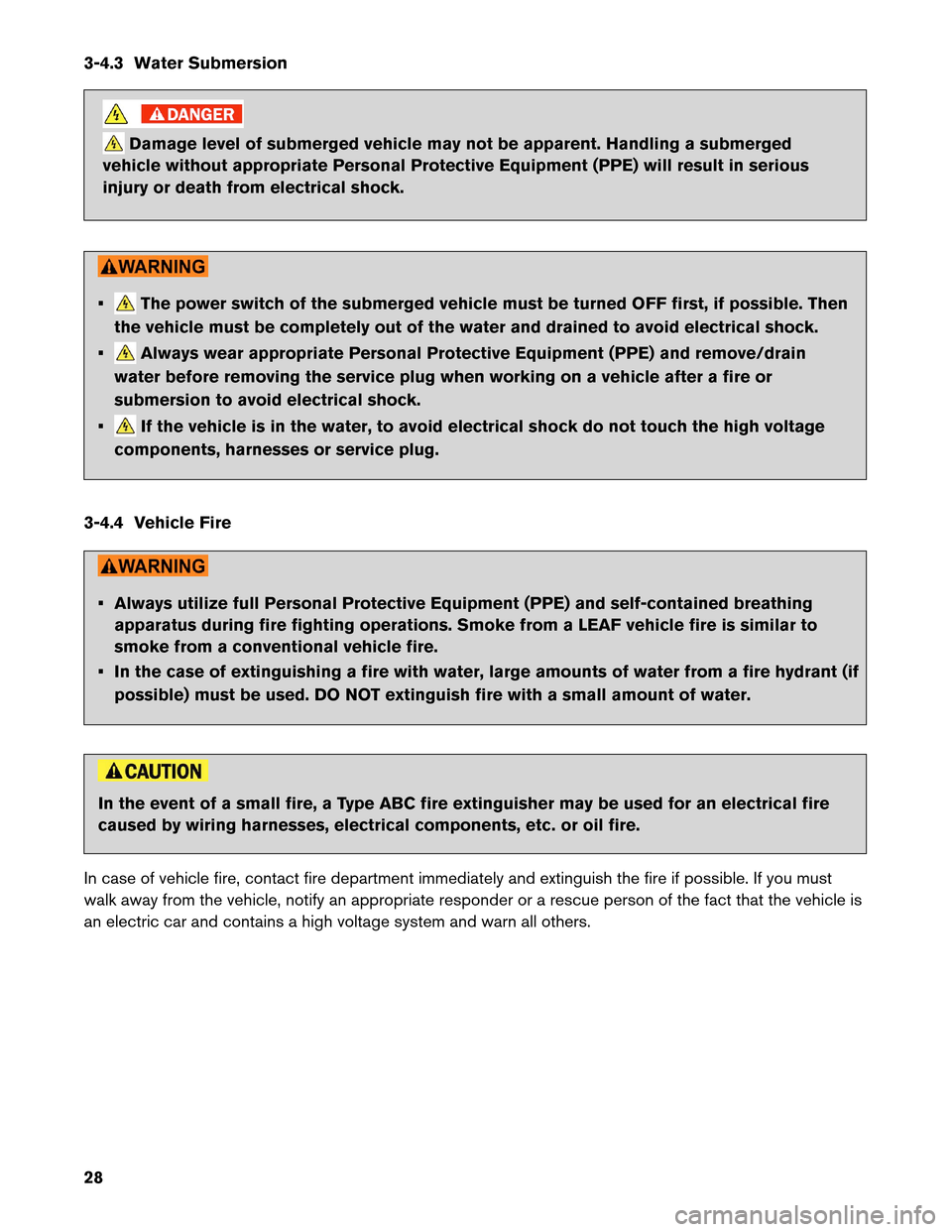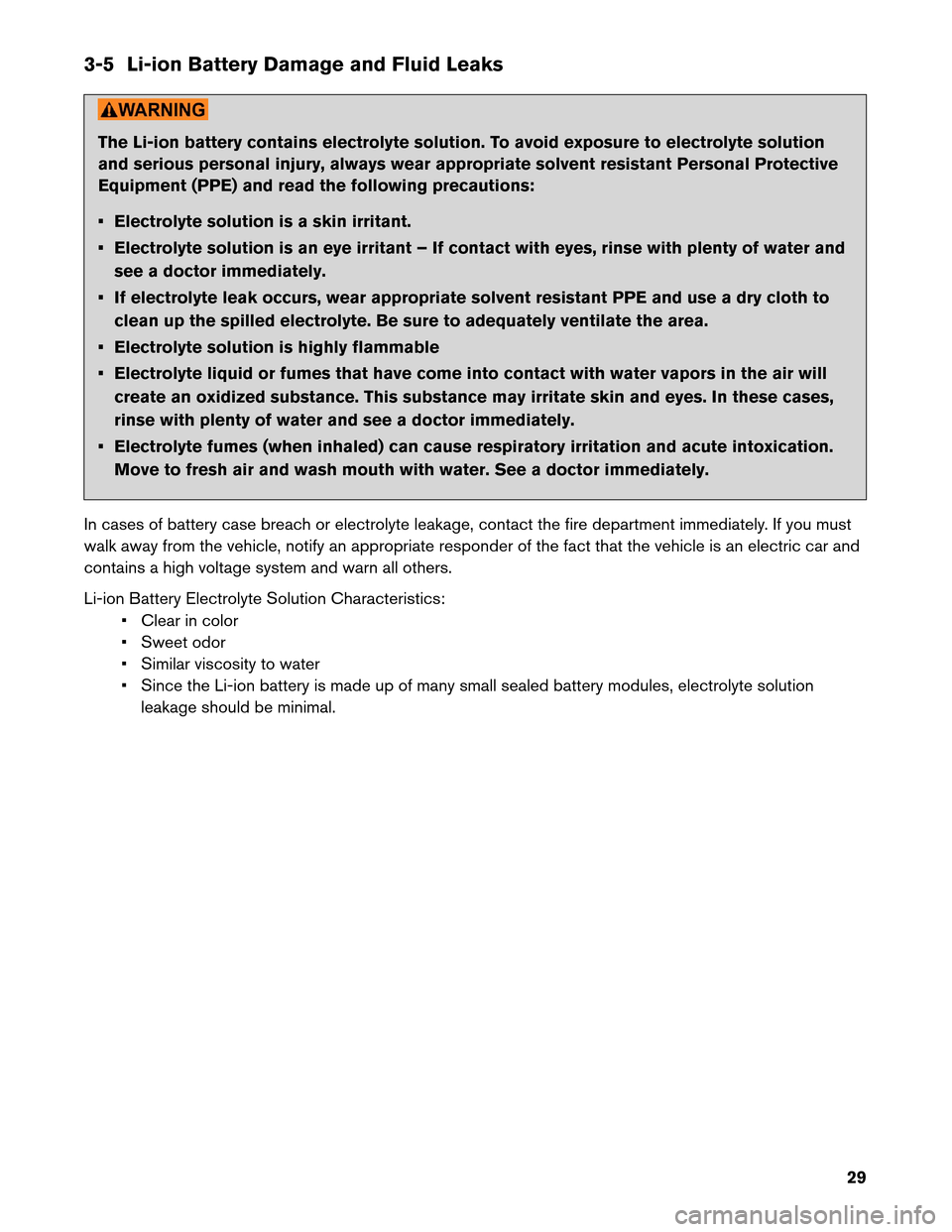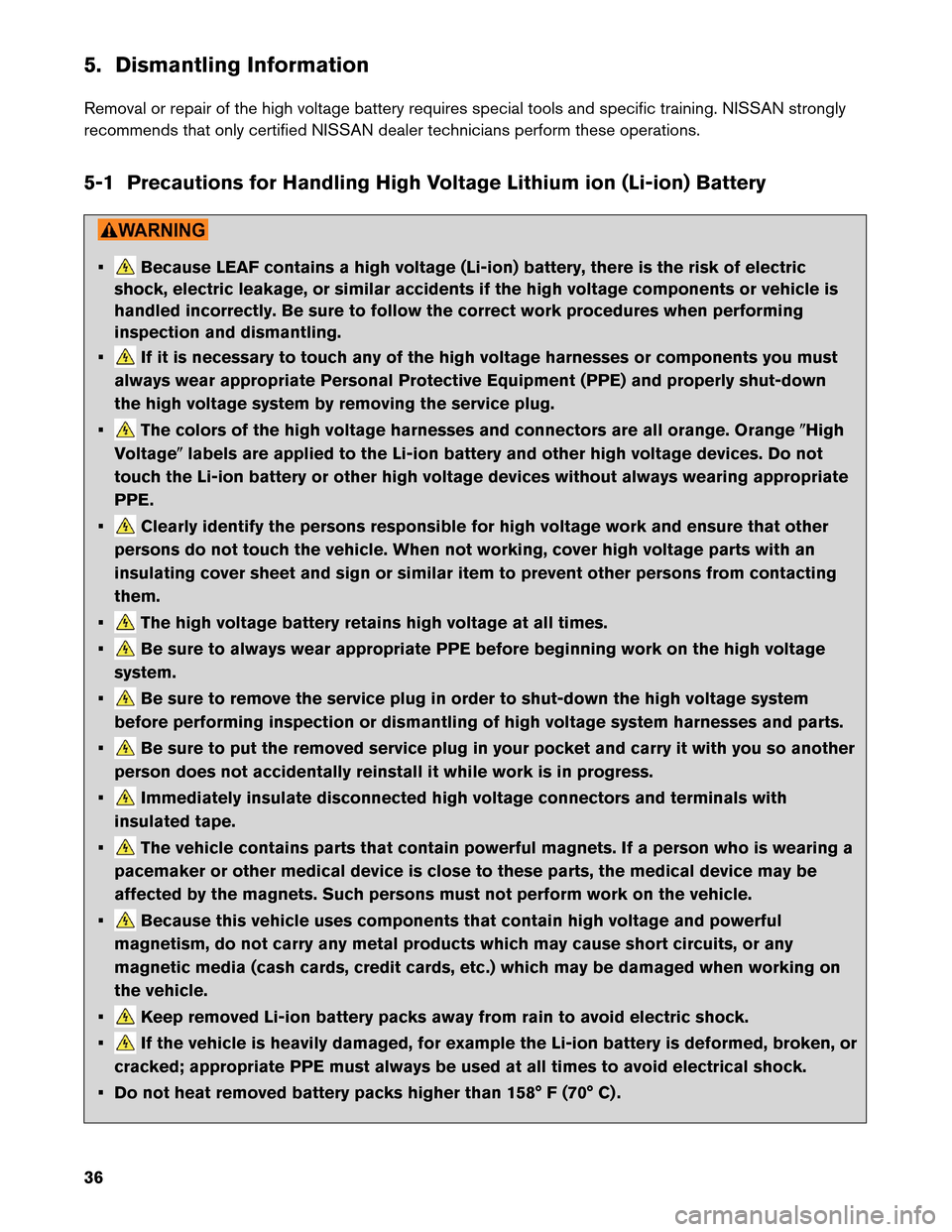ESP NISSAN LEAF 2013 1.G Dismantling Guide
[x] Cancel search | Manufacturer: NISSAN, Model Year: 2013, Model line: LEAF, Model: NISSAN LEAF 2013 1.GPages: 44, PDF Size: 1.62 MB
Page 28 of 44

3-4.3 Water Submersion
Damage level of submerged vehicle may not be apparent. Handling a submerged
vehicle without appropriate Personal Protective Equipment (PPE) will result in serious
injury or death from electrical shock. • The power switch of the submerged vehicle must be turned OFF first, if possible. Then
the
vehicle must be completely out of the water and drained to avoid electrical shock.
• Always wear appropriate Personal Protective Equipment (PPE) and remove/drain
water
before removing the service plug when working on a vehicle after a fire or
submersion to avoid electrical shock.
• If the vehicle is in the water, to avoid electrical shock do not touch the high voltage
components,
harnesses or service plug.
3-4.4 Vehicle Fire • Always utilize full Personal Protective Equipment (PPE) and self-contained breathing
apparatus
during fire fighting operations. Smoke from a LEAF vehicle fire is similar to
smoke from a conventional vehicle fire.
• In the case of extinguishing a fire with water, large amounts of water from a fire hydrant (if possible) must be used. DO NOT extinguish fire with a small amount of water. In the event of a small fire, a Type ABC fire extinguisher may be used for an electrical fire
caused
by wiring harnesses, electrical components, etc. or oil fire.
In case of vehicle fire, contact fire department immediately and extinguish the fire if possible. If you must
walk away from the vehicle, notify an appropriate responder or a rescue person of the fact that the vehicle is
an electric car and contains a high voltage system and warn all others.
28
Page 29 of 44

3-5 Li-ion Battery Damage and Fluid Leaks
The Li-ion battery contains electrolyte solution. To avoid exposure to electrolyte solution
and
serious personal injury, always wear appropriate solvent resistant Personal Protective
Equipment (PPE) and read the following precautions:
• Electrolyte solution is a skin irritant.
• Electrolyte solution is an eye irritant – If contact with eyes, rinse with plenty of water and
see a doctor immediately.
• If electrolyte leak occurs, wear appropriate solvent resistant PPE and use a dry cloth to clean up the spilled electrolyte. Be sure to adequately ventilate the area.
• Electrolyte solution is highly flammable
• Electrolyte liquid or fumes that have come into contact with water vapors in the air will create an oxidized substance. This substance may irritate skin and eyes. In these cases,
rinse with plenty of water and see a doctor immediately.
• Electrolyte fumes (when inhaled) can cause respiratory irritation and acute intoxication. Move to fresh air and wash mouth with water. See a doctor immediately.
In cases of battery case breach or electrolyte leakage, contact the fire department immediately. If you must
walk away from the vehicle, notify an appropriate responder of the fact that the vehicle is an electric car and
contains a high voltage system and warn all others.
Li-ion Battery Electrolyte Solution Characteristics: • Clear in color
• Sweet odor
• Similar viscosity to water
• Since the Li-ion battery is made up of many small sealed battery modules, electrolyte solutionleakage should be minimal.
29
Page 36 of 44

5. Dismantling Information
Removal
or repair of the high voltage battery requires special tools and specific training. NISSAN strongly
recommends that only certified NISSAN dealer technicians perform these operations.
5-1 Precautions for Handling High Voltage Lithium ion (Li-ion) Battery •
Because LEAF contains a high voltage (Li-ion) battery, there is the risk of electric
shock,
electric leakage, or similar accidents if the high voltage components or vehicle is
handled incorrectly. Be sure to follow the correct work procedures when performing
inspection and dismantling.
• If it is necessary to touch any of the high voltage harnesses or components you must
always
wear appropriate Personal Protective Equipment (PPE) and properly shut-down
the high voltage system by removing the service plug.
• The colors of the high voltage harnesses and connectors are all orange. Orange
�High
V
oltage� labels are applied to the Li-ion battery and other high voltage devices. Do not
touch the Li-ion battery or other high voltage devices without always wearing appropriate
PPE.
• Clearly identify the persons responsible for high voltage work and ensure that other
persons
do not touch the vehicle. When not working, cover high voltage parts with an
insulating cover sheet and sign or similar item to prevent other persons from contacting
them.
• The high voltage battery retains high voltage at all times.
• Be sure to always wear appropriate PPE before beginning work on the high voltage
system.
• Be sure to remove the service plug in order to shut-down the high voltage system
before
performing inspection or dismantling of high voltage system harnesses and parts.
• Be sure to put the removed service plug in your pocket and carry it with you so another
person
does not accidentally reinstall it while work is in progress.
• Immediately insulate disconnected high voltage connectors and terminals with
insulated
tape.
• The vehicle contains parts that contain powerful magnets. If a person who is wearing a
pacemaker
or other medical device is close to these parts, the medical device may be
affected by the magnets. Such persons must not perform work on the vehicle.
• Because this vehicle uses components that contain high voltage and powerful
magnetism,
do not carry any metal products which may cause short circuits, or any
magnetic media (cash cards, credit cards, etc.) which may be damaged when working on
the vehicle.
• Keep removed Li-ion battery packs away from rain to avoid electric shock.
• If the vehicle is heavily damaged, for example the Li-ion battery is deformed, broken, or
cracked;
appropriate PPE must always be used at all times to avoid electrical shock.
• Do not heat removed battery packs higher than 158° F (70° C) .
36